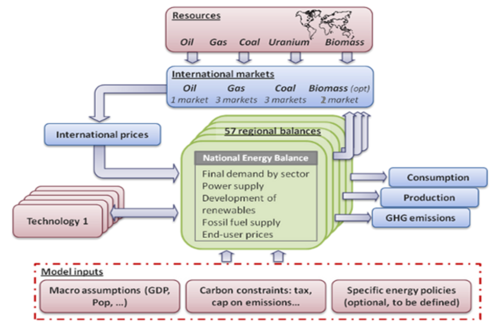Model scope and methods - POLES: Difference between revisions
No edit summary |
mNo edit summary |
||
| Line 20: | Line 20: | ||
Key input assumptions are population and growth of GDP per capita. The economic activity is then derived by the model at sectoral level, depending on economic growth and energy prices: economic sector value added, passengers and goods mobility, building stocks, etc.. | Key input assumptions are population and growth of GDP per capita. The economic activity is then derived by the model at sectoral level, depending on economic growth and energy prices: economic sector value added, passengers and goods mobility, building stocks, etc.. | ||
Other critical assumptions are energy resources by type and | Other critical assumptions are energy resources by type and localization. | ||
Revision as of 16:36, 22 December 2016
| Corresponding documentation | |
|---|---|
| Previous versions | |
| Model information | |
| Model link | |
| Institution | JRC - Joint Research Centre - European Commission (EC-JRC), Belgium, http://ec.europa.eu/jrc/en/. |
| Solution concept | Partial equilibrium (price elastic demand) |
| Solution method | SimulationRecursive simulation |
| Anticipation | Myopic |
POLES (Prospective Outlook on Long-term Energy Systems) is a global recursive dynamic simulation model of the energy system and covers all anthropogenic greenhouse gases emissions.
It allows to simulate a wide range of energy policies, be they on the demand side or on the supply sector. It displays a high regional resolution and sectoral representation, and provide endogenous simulation of all steps of the energy system by vector and sector: final energy demand, transformation (including power generation), trade, primary supply, international and final user prices.
- The model describes full energy balances for 57 countries and regions covering the World, and primary supply for 80 countries / regions, as well as energy commodities trade and trade routes.
- It operates on a yearly time step and benefits from frequently updated databases, allowing it to capture the most recent developments of energy markets in various countries / regions.
- Additional modules allow covering GHG emissions from industrial sources; agriculture and land-use emissions are derived from a soft linkage with the GLOBIOM model.
<xr id="fig:POLES_1"/> below gives a schematic view of the POLES model. The red boxes are the main assumptions, calibration and scenario settings; the green box represents the energy balance resolution by country / region and the blue boxes represent the trade and key outputs (demand, supply, emissions).
<figure id="fig:POLES_1">
</figure>
Key input assumptions are population and growth of GDP per capita. The economic activity is then derived by the model at sectoral level, depending on economic growth and energy prices: economic sector value added, passengers and goods mobility, building stocks, etc..
Other critical assumptions are energy resources by type and localization.
